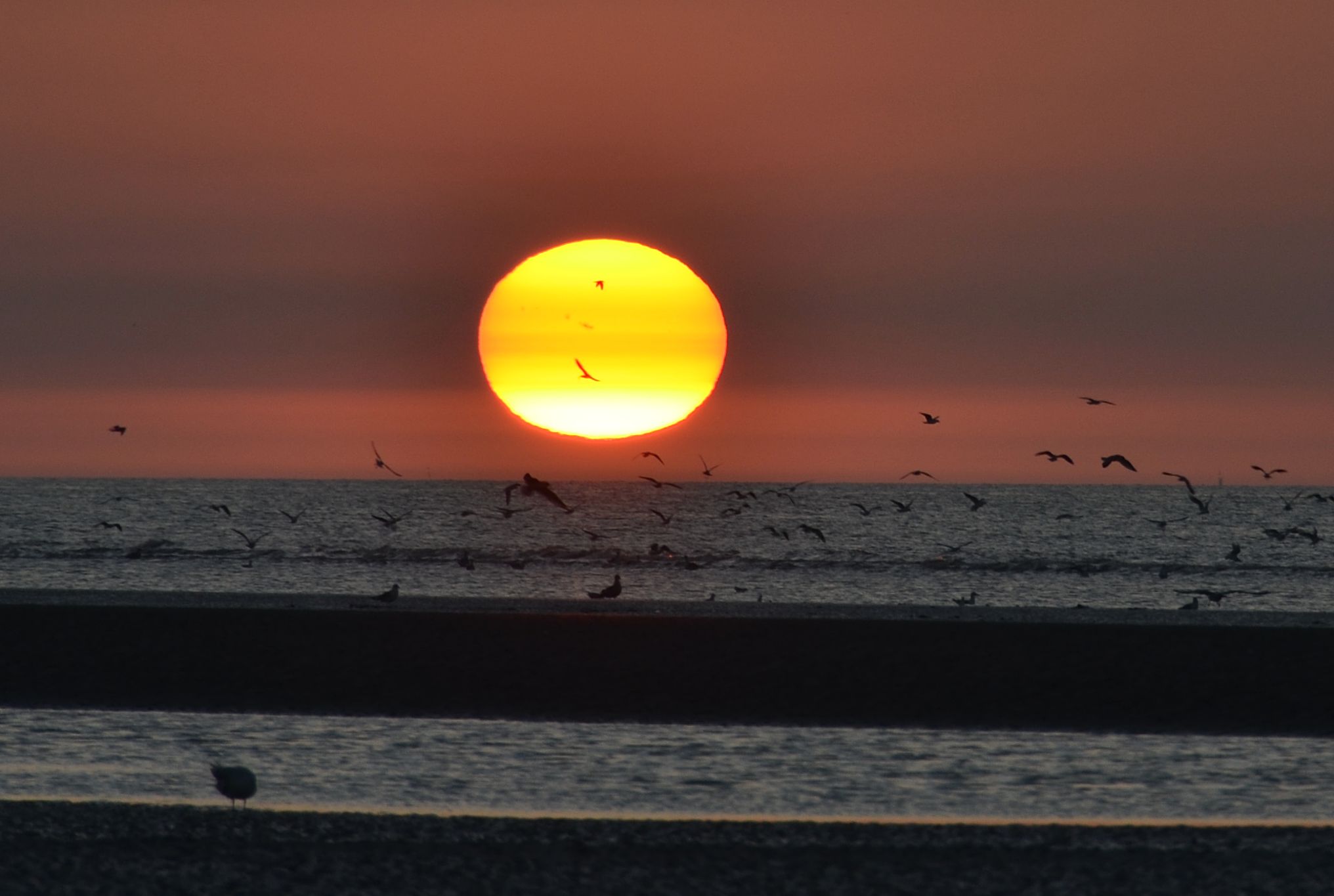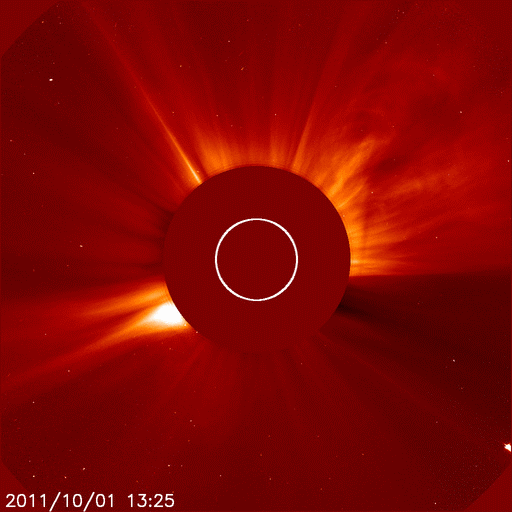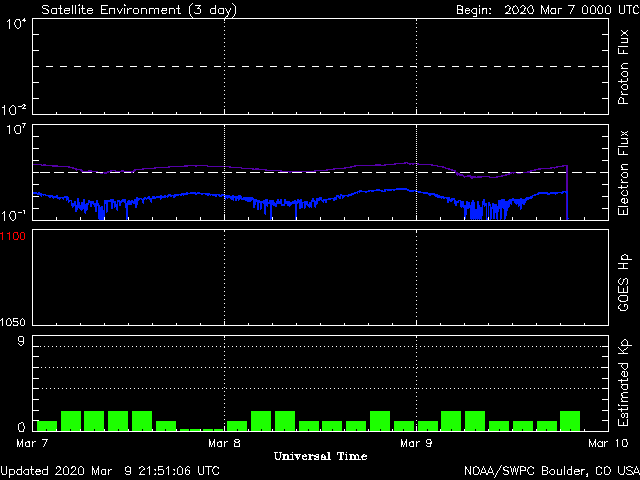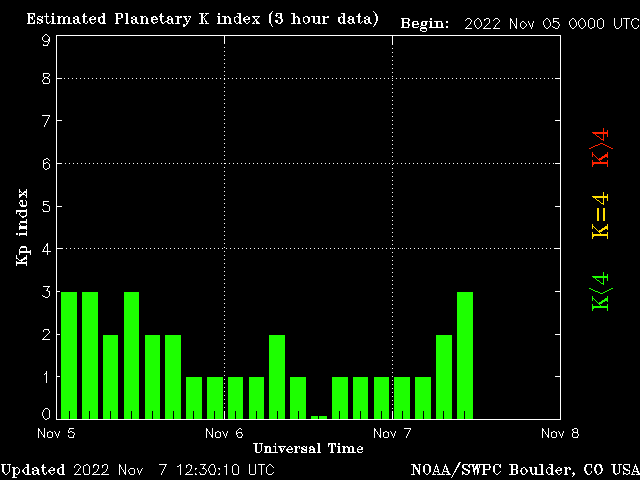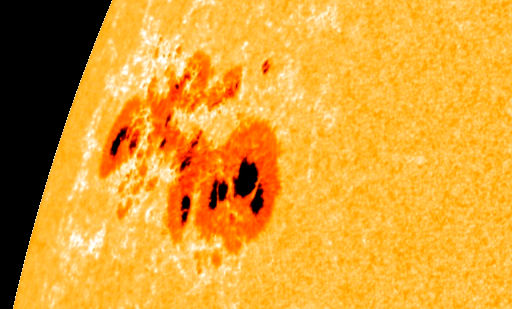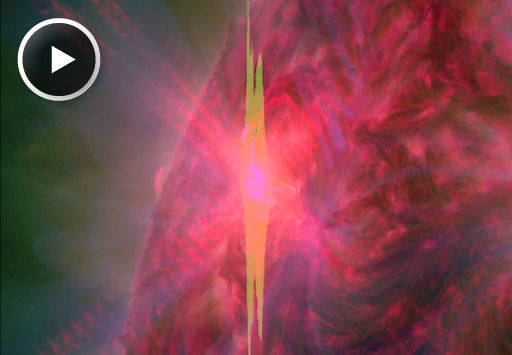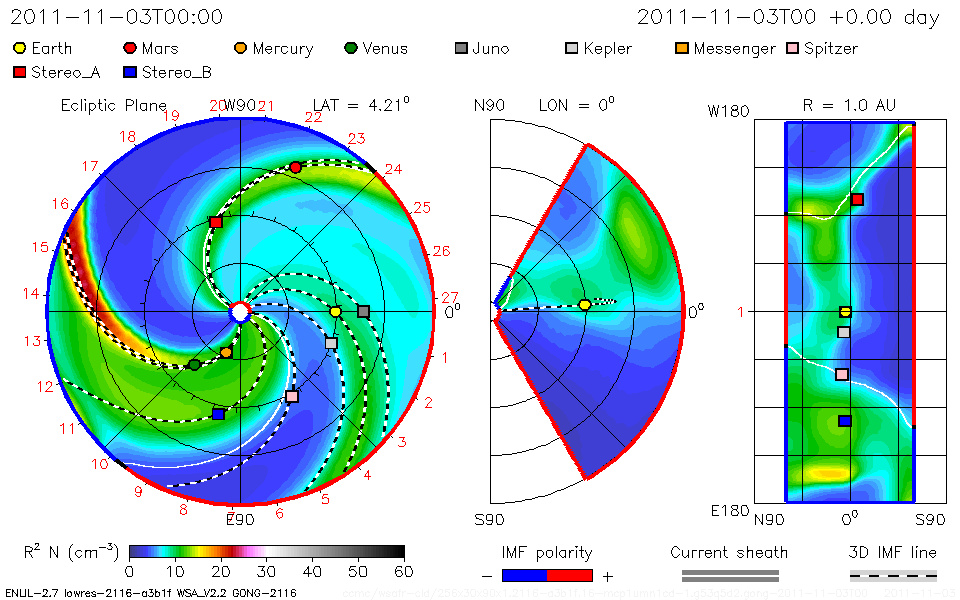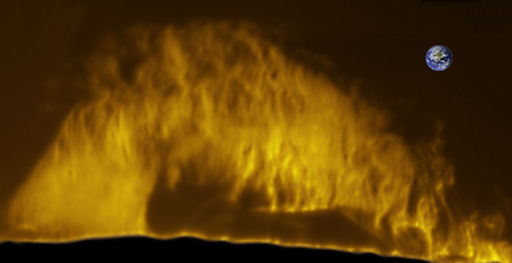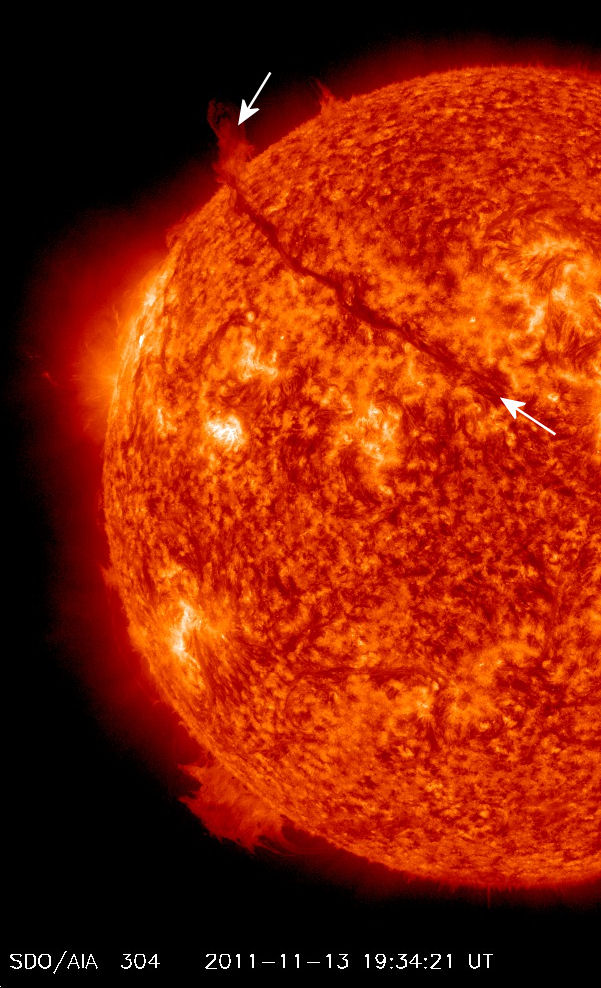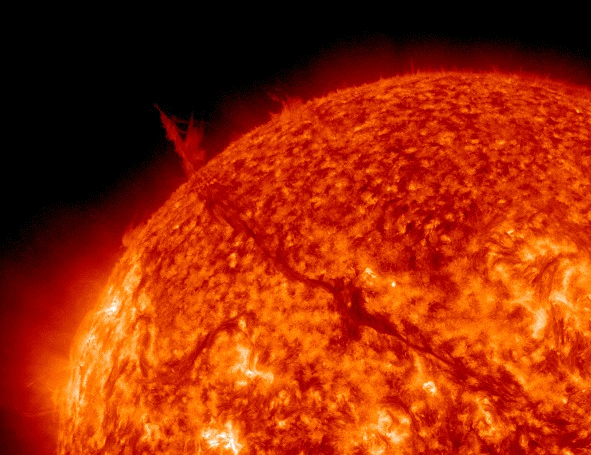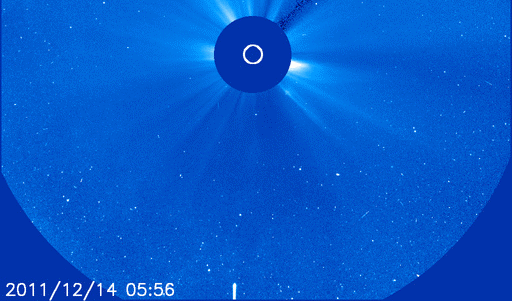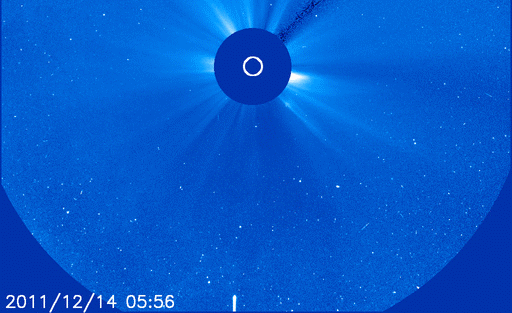WKN Weer, Klimaat en Natuurrampen
Lees alles over het onstuimige weer op onze planeet, volg orkanen en tornado's, zie hoe vulkanen uitbarsten en hoe Moeder Aarde beeft bij een aardbeving. Alles over de verwoestende kracht van onze planeet en tal van andere natuurverschijnselen.



quote:Mega quakes occur more frequently when sun has fewer sunspots: researchers
The frequency of mega earthquakes increases during periods when the sun has fewer sunspots, a team of Japanese researchers has found.
The finding was made by a team led by Kiyofumi Yumoto, a researcher in space and earth electromagnetism at Kyushu University's Space Environment Research Center.
The March 11 Great East Japan Earthquake occurred when there were few sunspots. The latest research suggests that the sun's activity could influence movements beneath the earth's surface.
Sunspots gradually increase and decrease in number in a cycle of about 11 years, and cause changes in the earth's atmosphere. The research team investigated the possibility that they could also produce changes beneath the earth's surface, and compared data on the number of sunspots between 1963 and 2000 and the 327,625 earthquakes of magnitude 4 or more that occurred during this period.
The study found that 65 percent of the earthquakes with magnitudes between 4.0 and 4.9 occurred during the periods with the fewest sunspots (each lasting about two years). The figure was around the same for earthquakes with magnitudes between 5.0 and 7.9. However, the figure was higher for the 28 mega earthquakes with magnitudes in the 8.0-9.9 range, with 79 percent of them occurring during periods with the fewest sunspots.
When there are fewer sunspots, a phenomenon occurs in which solar winds, or streams of charged particles from the sun, get stronger an average of three to four times a month. Seventy percent of the earthquakes of magnitude 6.0 or stronger occurred at such times.
Solar winds that become stormy are known to be able to induce strong currents in power transmission lines, which can lead to major blackouts.
"The relationship between the sun and the activity of earthquakes is not clear, but we hope that this is a step in uncovering the mystery of quakes," Yumoto said.
The results of the group's research will be announced at a meeting of the Society of Geomagnitism and Earth, Planetary and Space Sciences, which opens in Kobe on Nov. 3.


CME(ťťn van de ..) is aangekomen: KP=8!!! Zelfs in BelgiŽ is nu poollicht te zien....wie kan de bewolking en regen ff wegduwen, dan zouden we hier ook wat kunnen zien!
Crazy as Always...met vleugels natuurlijk..;-0


En dat was nog nieteens recht op de Aarde gericht. Misschien dat "schampschoten" wel meer impact hebben dan directe?quote:Op maandag 26 september 2011 21:58 schreef zenkelly het volgende:
CME(ťťn van de ..) is aangekomen: KP=8!!! Zelfs in BelgiŽ is nu poollicht te zien....wie kan de bewolking en regen ff wegduwen, dan zouden we hier ook wat kunnen zien!
Komen we misschien nog achter als zonnevlek 1302 nog een keertje blaast deze week.


KP 8.33
<a href="http://www.vwkweb.nl/" rel="nofollow" target="_blank">[b]Vereniging voor weerkunde en klimatologie[/b]</a>
<a href="http://www.estofex.org/" rel="nofollow" target="_blank">[b]ESTOFEX[/b]</a>
<a href="http://www.estofex.org/" rel="nofollow" target="_blank">[b]ESTOFEX[/b]</a>


Ik las iets over de sterkste geomagnetische storm sinds december 2006 ofzo.quote:Op maandag 26 september 2011 21:58 schreef zenkelly het volgende:
CME(ťťn van de ..) is aangekomen: KP=8!!! Zelfs in BelgiŽ is nu poollicht te zien....wie kan de bewolking en regen ff wegduwen, dan zouden we hier ook wat kunnen zien!
Zal me benieuwen of er nu ook een zeer zware aardbeving zal volgen binnen een paar dagen


Ook hiermee: spannend! Maar de aardbevingen nemen toch toe als er MINDER zonnevlekken zijn, of lees ik het nu niet goed? Dan zou je kunnen zeggen: zon actief met stormen en vlekken= minder aardbevingen?  Of ben ik nu ineens blont?
Of ben ik nu ineens blont? 
Crazy as Always...met vleugels natuurlijk..;-0


Klopt, bij minder zonnevlekken zouden er zwaardere aardbevingen zijn. Mogelijk omdat dan de straling heftiger is. Schijnbaar was de straling van deze solarflare ook bijzonder heftig.
Geen idee precies waarom want het was geen X-flare dacht ik?
Het is voor mij beginnende en boeiende materie
Geen idee precies waarom want het was geen X-flare dacht ik?
Het is voor mij beginnende en boeiende materie


Dat kan ik nergens lezen op spaceweather.com... maar we kijken nu wel bijna recht in de loop van het geweer.quote:
Btw... deze astroÔde staat ook maar pas in het lijstje:
2011 SE58 Sep 27 0.6 LD -- 13 m


quote:Op dinsdag 27 september 2011 20:00 schreef DemonRage het volgende:
[..]
Dat kan ik nergens lezen op spaceweather.com... maar we kijken nu wel bijna recht in de loop van het geweer.
twitter:spaceweather twitterde op dinsdag 27-09-2011 om 19:01:23 Sunspot 1302: It's Big. It's Bad. And It's Coming Our Way http://srs.gs/16hN reageer retweet


Zag hem ook... maar tis maar een kleintje... die eind van het jaar komt dat is er zeker eentje die het nieuws gaat halenquote:Op dinsdag 27 september 2011 20:00 schreef DemonRage het volgende:
Btw... deze astroÔde staat ook maar pas in het lijstje:
2011 SE58 Sep 27 0.6 LD -- 13 m


Die van 8 november toch? Zo'n rotsblok van 175 meter doorsnede moeten we toch wel kunnen zien als die voor de zon langs gaat (weliswaar door een filter).quote:Op dinsdag 27 september 2011 20:08 schreef Frutsel het volgende:
[..]
Zag hem ook... maar tis maar een kleintje... die eind van het jaar komt dat is er zeker eentje die het nieuws gaat halen


Het was officiŽel de M7 flare die aankwam, maar had ook ergens gelezen(weet niet meer waar) dat het een combi was van de meerdere uitbarstingen, die elkaar versterkt hebben. De ťťn haalde de ander in enzovoort...wie t weet, mag t zeggen.quote:[Schijnbaar was de straling van deze solarflare ook bijzonder heftig.
Geen idee precies waarom want het was geen X-flare dacht ik?
Crazy as Always...met vleugels natuurlijk..;-0


Vlekje 1302 staat nu recht op ons gericht... als die nou gaat blazen dan wordt het spannend.
Foto van de zonsondergang vanuit BelgiŽ (Spaceweather):
Foto van de zonsondergang vanuit BelgiŽ (Spaceweather):


Waaaaauw, kan me haast niet voorstellen dat dit echt is!quote:Op woensdag 28 september 2011 20:58 schreef Roel_Jewel het volgende:
Noorderlicht vanuit het ISS:
[ afbeelding ]
Drugs are good mkay?


Bizarre plaatjes van het noorderlicht:
Bron Spaceweather
Bron Spaceweather
Weer of geen weer, altijd actueel www.onweer-online.nl


Gaaf zeg!! 
Doe mee met het voorspellen van het weer!
Weekvoorspelling | Week 45 (invullen tot 3-11 11:59)
Maandvoorspelling November (Gesloten)
Jaarvoorspelling 2024 / 2025
Weekvoorspelling | Week 45 (invullen tot 3-11 11:59)
Maandvoorspelling November (Gesloten)
Jaarvoorspelling 2024 / 2025


Uit eigen keuken...quote:Op woensdag 28 september 2011 20:25 schreef DemonRage het volgende:
Vlekje 1302 staat nu recht op ons gericht... als die nou gaat blazen dan wordt het spannend.
Foto van de zonsondergang vanuit BelgiŽ (Spaceweather):
[ afbeelding ]
Gecropt
<a href="http://www.vwkweb.nl/" rel="nofollow" target="_blank">[b]Vereniging voor weerkunde en klimatologie[/b]</a>
<a href="http://www.estofex.org/" rel="nofollow" target="_blank">[b]ESTOFEX[/b]</a>
<a href="http://www.estofex.org/" rel="nofollow" target="_blank">[b]ESTOFEX[/b]</a>


Whow prachtig!!! Wat voor lens heb je dat gemaakt?quote:Op woensdag 28 september 2011 21:11 schreef -CRASH- het volgende:
[..]
Uit eigen keuken...
[ link | afbeelding ]
Gecropt
[ link | afbeelding ]
Weer of geen weer, altijd actueel www.onweer-online.nl


+- 676mm lensquote:Op woensdag 28 september 2011 21:56 schreef meteo-online het volgende:
[..]
Whow prachtig!!! Wat voor lens heb je dat gemaakt?
Olympus SP 590 UZ
[ Bericht 13% gewijzigd door -CRASH- op 29-09-2011 00:16:09 ]
<a href="http://www.vwkweb.nl/" rel="nofollow" target="_blank">[b]Vereniging voor weerkunde en klimatologie[/b]</a>
<a href="http://www.estofex.org/" rel="nofollow" target="_blank">[b]ESTOFEX[/b]</a>
<a href="http://www.estofex.org/" rel="nofollow" target="_blank">[b]ESTOFEX[/b]</a>


Aim, fire.quote:Op woensdag 28 september 2011 20:25 schreef DemonRage het volgende:
Vlekje 1302 staat nu recht op ons gericht... als die nou gaat blazen dan wordt het spannend.
Foto van de zonsondergang vanuit BelgiŽ (Spaceweather):
[ afbeelding ]


Er was gisteren (1 oktober) een komeet onderweg naar de zon, zie beelden van SOHO LASCO C2 en C3:
En twee beelden van net, grote vlammen veroorzaakt door de komeet (??)
De frames tussen 15:00 en 21:00 missen helaas, dus ik kan (nog) niet zien hoe ver de komeet is gekomen.
En twee beelden van net, grote vlammen veroorzaakt door de komeet (??)
De frames tussen 15:00 en 21:00 missen helaas, dus ik kan (nog) niet zien hoe ver de komeet is gekomen.


De uitbarstingen waren van zonnevlekken 1302 (die hele grote) en 1305 (ook niet echt een kleintje en recht op de aarde gericht). 1305 heeft een CME afgeschoten die ons op 4 oktober bereikt.
Spaceweather.com
Het valt me trouwens op dat er nog geen klasseringen zijn voor deze zonnevlammen.
[ Bericht 23% gewijzigd door DemonRage op 02-10-2011 12:58:36 ]
Spaceweather.com
Het valt me trouwens op dat er nog geen klasseringen zijn voor deze zonnevlammen.
[ Bericht 23% gewijzigd door DemonRage op 02-10-2011 12:58:36 ]


Op Speceweather nog niet, idd...Solarham wel:quote:Het valt me trouwens op dat er nog geen klasseringen zijn voor deze zonnevlammen.
Ben benieuwd naar de impact.....quote:M3.9 Flare: Sunspot 1305 continues to grow and at 00:50 UTC Sunday morning, an M3.9 Solar Flare took place. A Coronal Mass Ejection (CME) resulted, however the blast from the earlier M1.2 Solar Flare appears to be more geoeffective.
Long Duration M-Flare + CME: A long duration M1.2 Solar Flare took place around Sunspot 1305 at 09:59 UTC Saturday morning and a Earth Directed CME is on its way. The cloud of plasma is slow moving at 500 km/s.
Crazy as Always...met vleugels natuurlijk..;-0


Dus we krijgen een dubbele CME om onze oren... da's idd spannend.quote:Op zondag 2 oktober 2011 13:03 schreef zenkelly het volgende:
[..]
Op Speceweather nog niet, idd...Solarham wel:
[..]
Ben benieuwd naar de impact.....


Zoiets.....quote:Op zondag 2 oktober 2011 12:50 schreef DemonRage het volgende:
De uitbarstingen waren van zonnevlekken 1302 (die hele grote) en 1305 (ook niet echt een kleintje en recht op de aarde gericht). 1305 heeft een CME afgeschoten die ons op 4 oktober bereikt.
Spaceweather.com
Het valt me trouwens op dat er nog geen klasseringen zijn voor deze zonnevlammen.
Classification
The Sun shows a C3-class solar flare (white area on upper left), a solar tsunami (wave-like structure, upper right) and multiple filaments of magnetism lifting off the stellar surface.
Solar flares are classified as A, B, C, M or X according to the peak flux (in watts per square meter, W/m2) of 100 to 800 picometer X-rays near Earth, as measured on the GOES spacecraft. Each class has a peak flux ten times greater than the preceding one, with X class flares having a peak flux of order 10−4 W/m2. Within a class there is a linear scale from 1 to 9, so an X2 flare is twice as powerful as an X1 flare, and is four times more powerful than an M5 flare. The more powerful M and X class flares are often associated with a variety of effects on the near-Earth space environment. This extended logarithmic classification is necessary because the total energies of flares range over many orders of magnitude, following a uniform distribution with flare frequency roughly proportional to the inverse of the total energy. Stellar flares and earthquakes show similar power-law distributions.[5]
Another flare classification is based on Hα spectral observations. The scheme uses both the intensity and emitting surface. The classification in intensity is qualitative, referring the flares as: (f)aint, (n)ormal or (b)rilliant. The emitting surface is measured in terms of millionths of the hemisphere and is described below (The total hemisphere area AH=6.2 1012 km2.)
Classification ........ Corrected Area [millionths of hemisphere]
S.............................< 100
1.................................100 - 250
2.................................250 - 600
3.................................600 - 1200
4..............................> 1200
A flare then is classified taking S or a number that represents its size and a letter that represents its peak intensity, v.g.: Sn is a normal subflare
Classificatie Zonnevlammen
Wetenschappers classificeren zonnevlammen volgens de helderheid in de rŲntgenstraling.
Er zijn drie categorieŽn:
de X-klasse is zeer groot,
het zijn enorme gebeurtenissen die de oorzaak kunnen zijn van radio storingen over de hele Aarde en veroorzaken langdurige stralingsstormen in de bovenste lagen van de atmosfeer.
de M-klasse vlammen zijn middelmaat van grootte;
zij veroorzaken korte radiostoringen voornamelijk op hoge noorder en zuider breedtegraden. Geringe stralingsstormen volgen soms na een M-klasse vlam.
Vergeleken met X en M klasse gebeurtenissen
zijn C klasse vlammen klein en nauwelijks merkbaar op Aarde
<a href="http://www.vwkweb.nl/" rel="nofollow" target="_blank">[b]Vereniging voor weerkunde en klimatologie[/b]</a>
<a href="http://www.estofex.org/" rel="nofollow" target="_blank">[b]ESTOFEX[/b]</a>
<a href="http://www.estofex.org/" rel="nofollow" target="_blank">[b]ESTOFEX[/b]</a>


GIF filmpjes van de inslag en CME(s):quote:Op zondag 2 oktober 2011 00:10 schreef basst2005 het volgende:
Er was gisteren (1 oktober) een komeet onderweg naar de zon, zie beelden van SOHO LASCO C2 en C3:
[ afbeelding ]
[ afbeelding ]
En twee beelden van net, grote vlammen veroorzaakt door de komeet (??)
[ afbeelding ]
[ afbeelding ]
De frames tussen 15:00 en 21:00 missen helaas, dus ik kan (nog) niet zien hoe ver de komeet is gekomen.
http://www.basst.nl/wp-co(...)Komeet_in_Zon_c2.gif
http://www.basst.nl/wp-co(...)Komeet_in_Zon_c3.gif


Het ziet er anders toch verdacht uit...
COMET AND CME: A comet discovered by amateur astronomers on Friday, Sept. 30th, disintegrated in spectacular fashion the very next day when it plunged into the sun. The Solar and Heliospheric Observatory recorded the comet's last hours. The end was punctuated by an unexpected explosion:
The timing of the CME so soon after the comet dove into the sun suggests a link. But what? There is no known mechanism for comets to trigger solar explosions. Before 2011 most solar physicists would have discounted the events of Oct. 1st as pure coincidence--and pure coincidence is still the most likely explanation. Earlier this year, however, the Solar Dynamics Observatory (SDO) watched another sungrazer disintegrate in the sun's atmosphere. On July 5, 2011, the unnamed comet appeared to interact with plasma and magnetic fields in its surroundings as it fell apart. Could a puny comet cause a magnetic instability that might propagate and blossom into a impressive CME? The question is not so crazy as it once seemed to be.
COMET AND CME: A comet discovered by amateur astronomers on Friday, Sept. 30th, disintegrated in spectacular fashion the very next day when it plunged into the sun. The Solar and Heliospheric Observatory recorded the comet's last hours. The end was punctuated by an unexpected explosion:
The timing of the CME so soon after the comet dove into the sun suggests a link. But what? There is no known mechanism for comets to trigger solar explosions. Before 2011 most solar physicists would have discounted the events of Oct. 1st as pure coincidence--and pure coincidence is still the most likely explanation. Earlier this year, however, the Solar Dynamics Observatory (SDO) watched another sungrazer disintegrate in the sun's atmosphere. On July 5, 2011, the unnamed comet appeared to interact with plasma and magnetic fields in its surroundings as it fell apart. Could a puny comet cause a magnetic instability that might propagate and blossom into a impressive CME? The question is not so crazy as it once seemed to be.
<a href="http://www.vwkweb.nl/" rel="nofollow" target="_blank">[b]Vereniging voor weerkunde en klimatologie[/b]</a>
<a href="http://www.estofex.org/" rel="nofollow" target="_blank">[b]ESTOFEX[/b]</a>
<a href="http://www.estofex.org/" rel="nofollow" target="_blank">[b]ESTOFEX[/b]</a>


De bron is een bericht uit februari hoorquote:Op dinsdag 11 oktober 2011 16:49 schreef Maron het volgende:
http://www.earth-matters.(...)reem-ruimteweer.html


Misschien valt 't daarom ook onder 'grenswetenschap'quote:Op dinsdag 11 oktober 2011 16:55 schreef Frutsel het volgende:
[..]
De bron is een bericht uit februari hoor
And what rough beast, its hour come round at last,
Slouches towards Bethlehem to be born?
Slouches towards Bethlehem to be born?


Ghehee, naja, het viel mij ook pas op nadat er stond dat dit de eerste X-flare was ... en toen dacht ik: huh? egnie...



While looking at the latest STEREO Ahead images, there appears to be a very bright and possibly a partially earth directed Coronal Mass Ejection blasting away from the Sun during the early hours on Saturday. The source of this explosion may have been a Solar Filament burst. Please watch the video below.
Crazy as Always...met vleugels natuurlijk..;-0


bron:solarham.comquote:Op zaterdag 22 oktober 2011 15:02 schreef zenkelly het volgende:
While looking at the latest STEREO Ahead images, there appears to be a very bright and possibly a partially earth directed Coronal Mass Ejection blasting away from the Sun during the early hours on Saturday. The source of this explosion may have been a Solar Filament burst. Please watch the video below.
Crazy as Always...met vleugels natuurlijk..;-0


Is er iemand die rond de 26ste toevallig op vakantie is op Mars 
Er gaat namelijk een CME die richting op
SPACE WEATHER FORECAST FOR MARS:
Er gaat namelijk een CME die richting op
SPACE WEATHER FORECAST FOR MARS:
<a href="http://www.vwkweb.nl/" rel="nofollow" target="_blank">[b]Vereniging voor weerkunde en klimatologie[/b]</a>
<a href="http://www.estofex.org/" rel="nofollow" target="_blank">[b]ESTOFEX[/b]</a>
<a href="http://www.estofex.org/" rel="nofollow" target="_blank">[b]ESTOFEX[/b]</a>


Dan zal het vast een man zijnquote:Is er iemand die rond de 26ste toevallig op vakantie is op Mars
Crazy as Always...met vleugels natuurlijk..;-0


Op dit moment is er een magnetische storm aan de gang, Kp 7
Rode band te zien van het westen tot helemaal naar het oosten, te zien door de gaten in de wolken half bewolkt 0.45
half bewolkt 0.45
Het wordt nu minder helder, alleen nog een beetje een paarse gloed 1.00
Het is nu echt weg 1.15
1.15
[ Bericht 6% gewijzigd door blids op 25-10-2011 07:01:28 ]
Rode band te zien van het westen tot helemaal naar het oosten, te zien door de gaten in de wolken
Het wordt nu minder helder, alleen nog een beetje een paarse gloed 1.00
Het is nu echt weg
[ Bericht 6% gewijzigd door blids op 25-10-2011 07:01:28 ]


Waarom keek ik nu gister niet in dit topic 
Van rond middernacht... en ik was nog wakker ook. http://www.adressa.no/nyheter/trondheim/article1716182.ece
Van rond middernacht... en ik was nog wakker ook. http://www.adressa.no/nyheter/trondheim/article1716182.ece
I'm surrounded by morons!
TRV plannen/geboekt 2026: Peru, BelgiŽ, Nederland, St. Maarten
TRV plannen/geboekt 2025:Zuid-Amerika, Nederland, Chicago, Washington, Nederland, KroatiŽ, SloveniŽ, Parijs/Brussel/Nijmegen/Kopenhagen, Griekenland, Nederland, Nederland, Oslo
TRV 2024:Nederland, UK, Nederland, Denemarken, UK, Nederland, Noord-Noorwegen, Nederland, Atlanta
TRV plannen/geboekt 2026: Peru, BelgiŽ, Nederland, St. Maarten
TRV plannen/geboekt 2025:Zuid-Amerika, Nederland, Chicago, Washington, Nederland, KroatiŽ, SloveniŽ, Parijs/Brussel/Nijmegen/Kopenhagen, Griekenland, Nederland, Nederland, Oslo
TRV 2024:Nederland, UK, Nederland, Denemarken, UK, Nederland, Noord-Noorwegen, Nederland, Atlanta


Spaceweather.comquote:SOLAR ACTIVITY IN THE OFFING: A big sunspot is emerging over the sun's NE limb. Yesterday it unleashed an M1-class solar flare (SDO movie) and hurled a coronal mass ejection into space. Geoeffective solar activity could increase in the days ahead as the sun's rotation turns the sunspot toward Earth.


Wie in ScandinaviŽ woont
Opgelet! Noorderlicht is nu in heel ScandinaviŽ te zien, het wordt daar al donker Kp 5
Opgelet! Noorderlicht is nu in heel ScandinaviŽ te zien, het wordt daar al donker Kp 5


Hm...40.000km groot... das 2x heen en terug naar Tokyo ofzoquote:BIG SUNSPOT: A large sunspot group is rotating over the sun's northeastern limb, possibly signaling an uptick in solar activity. NASA's Solar Dynamics Observatory took this picture during the early hours of Nov. 2nd:
Measuring some 40,000 km wide and at least twice that in length, the behemoth active region is an easy target for backyard solar telescopes. Astronomers are encouraged to monitor the region: NOAA forecasters estimate a 60% chance of M-class solar flares during the next 24 hours. Eruptions today would not be Earth directed, but future eruptions could be as the sunspot turns toward our planet in the days ahead.


quote:One of the largest sunspots in years is rotating over the sun's northeastern limb. NASA's Solar Dynamics Observatory took this picture of AR1339 during the early hours of Nov. 3rd:
Measuring some 40,000 km wide and at least twice that in length, the sprawling sunspot group is an easy target for backyard solar telescopes. Two or three of the sunspot's dark cores are wider than Earth itself.
Naturally, such a large sunspot has potential for strong flares. NOAA forecasters estimate a 50% chance of M-class solar flares during the next 24 hours. One such eruption has already occured: An M4-flare at 2200 UT on Nov. 2nd produced a bright flash of extreme UV radiation (SDO movie) and hurled a coronal mass ejection (CME) into space. The CME is not heading our way. Future CMEs could have greater effect as AR1339 turns toward Earth in the days ahead


X-FLARE: Earth-orbiting satellites have just detected an X2-class solar flare. The source is huge sunspot AR1339, described below. Stay tuned for updates. Solar flare alerts: text, voice.
[ Bericht 53% gewijzigd door blids op 03-11-2011 23:27:11 ]
[ Bericht 53% gewijzigd door blids op 03-11-2011 23:27:11 ]


Gisteren een M4.33
Vandaag een M2.59 en een X1.99
Het gaat weer de goede kant uit
Vandaag een M2.59 en een X1.99
Het gaat weer de goede kant uit
<a href="http://www.vwkweb.nl/" rel="nofollow" target="_blank">[b]Vereniging voor weerkunde en klimatologie[/b]</a>
<a href="http://www.estofex.org/" rel="nofollow" target="_blank">[b]ESTOFEX[/b]</a>
<a href="http://www.estofex.org/" rel="nofollow" target="_blank">[b]ESTOFEX[/b]</a>


CHANCE OF FLARES: NOAA forecasters have upgraded the chance of X-class solar flares today to 20%. The source would be AR1339, one of the biggest sunspots in many years. The active region rotated over the sun's eastern limb two days ago and now it is turning toward Earth. Solar flare alerts:
The sunspot has already unleashed one X-flare on Nov. 3rd around 2027 UT. A movie from NASA's Solar Dynamics Observatory shows the extreme ultraviolet flash:
Bekijk filmpje op www.spaceweather.com
The flare created waves of ionization in Earth's upper atmosphere, altering the normal propagation of radio waves over Europe and the Americas. In Ireland, the flare's effect was felt even after dark.
A cloud of plasma or "CME" raced away from the blast site at 1100 km/s. The CME is not heading for Earth. It is, however, heading for Mercury and Venus. Click on the arrow to view a movie of the CME's forecast track:
[ Bericht 4% gewijzigd door -CRASH- op 04-11-2011 18:28:11 ]
The sunspot has already unleashed one X-flare on Nov. 3rd around 2027 UT. A movie from NASA's Solar Dynamics Observatory shows the extreme ultraviolet flash:
Bekijk filmpje op www.spaceweather.com
The flare created waves of ionization in Earth's upper atmosphere, altering the normal propagation of radio waves over Europe and the Americas. In Ireland, the flare's effect was felt even after dark.
A cloud of plasma or "CME" raced away from the blast site at 1100 km/s. The CME is not heading for Earth. It is, however, heading for Mercury and Venus. Click on the arrow to view a movie of the CME's forecast track:
[ Bericht 4% gewijzigd door -CRASH- op 04-11-2011 18:28:11 ]
<a href="http://www.vwkweb.nl/" rel="nofollow" target="_blank">[b]Vereniging voor weerkunde en klimatologie[/b]</a>
<a href="http://www.estofex.org/" rel="nofollow" target="_blank">[b]ESTOFEX[/b]</a>
<a href="http://www.estofex.org/" rel="nofollow" target="_blank">[b]ESTOFEX[/b]</a>


quote:5 M-class solar flares in 24 hours
November 6, 2011 – Sunspot AR1339 is crackling with M-class solar flares, unleashing at least five of them in the past 24 hours. The blasts have been coming with such thick frequency that photographer Randy Shivak of Elyria, Ohio, was able to catch one in action on Nov. 5th: “Looking like iron filings around a bar magnet, sunspot group 1339 showed itself in the throes of a solar flare,” says Shivak. Even bigger eruptions are possible before the weekend is over. AR1339 has a delta-class magnetic field that harbors energy for X-class flares. The sunspot is turning toward Earth, so the odds of a geo-effective flare are increasing. Sunspot 1339 has a delta-class magnetic field that harbors energy for X-class solar flares.


CHANCE OF FLARES:
Big sunspot 1339 has quieted since a flurry of M-flares on Saturday,
but the active region still poses a threat for strong eruptions.
NOAA forecasters estimate a 70% chance of M-flares and a
10% chance of X-flares during the next 24 hours
www.spaceweather.com
Big sunspot 1339 has quieted since a flurry of M-flares on Saturday,
but the active region still poses a threat for strong eruptions.
NOAA forecasters estimate a 70% chance of M-flares and a
10% chance of X-flares during the next 24 hours
www.spaceweather.com
<a href="http://www.vwkweb.nl/" rel="nofollow" target="_blank">[b]Vereniging voor weerkunde en klimatologie[/b]</a>
<a href="http://www.estofex.org/" rel="nofollow" target="_blank">[b]ESTOFEX[/b]</a>
<a href="http://www.estofex.org/" rel="nofollow" target="_blank">[b]ESTOFEX[/b]</a>


Een M1 klasse filamentuitbarsting op de zon, die gepaard ging met een grote
volledige halo CME, is op weg naar de Aarde. De aankomst is voorzien in de
nacht van 11 op 12 november en kan een kleine kans op poollicht veroorzaken
voor de Lage Landen.
Meer info over de poollichtkans op ons forum:
http://www.spaceweatherlive.com/community/index.php?topic=3149.0
volledige halo CME, is op weg naar de Aarde. De aankomst is voorzien in de
nacht van 11 op 12 november en kan een kleine kans op poollicht veroorzaken
voor de Lage Landen.
Meer info over de poollichtkans op ons forum:
http://www.spaceweatherlive.com/community/index.php?topic=3149.0
<a href="http://www.vwkweb.nl/" rel="nofollow" target="_blank">[b]Vereniging voor weerkunde en klimatologie[/b]</a>
<a href="http://www.estofex.org/" rel="nofollow" target="_blank">[b]ESTOFEX[/b]</a>
<a href="http://www.estofex.org/" rel="nofollow" target="_blank">[b]ESTOFEX[/b]</a>


quote:REMARKABLE SOLAR ACTIVITY: There haven't been any strong solar flares in days. Nevertheless, some impressive activity is underway on the sun. For one thing, an enormous wall of plasma is towering over the sun's southeastern horizon. Stephen Ramsden of Atlanta, Georgia, took this picture on Nov. 11th:
"Solar forums all over the world are buzzing with Sun-stronomers proclaiming this to be the biggest prominence that many of them had ever witnessed," he says.
Remarkably, though, this is not the biggest thing. A dark filament of magnetism is snaking more than halfway around the entire sun: SDO image. From end to end, it stretches more than a million km or about three times the distance between Earth and the Moon. If the filament becomes unstable, as solar filaments are prone to do, it could collapse and hit the stellar surface below, triggering a Hyder flare. No one can say if the eruption of such a sprawling structure would be Earth directed.
Bron: www.spaceweather.com


Nu zie je hoe klein we eigenlijk zijn 
Doe mee met het voorspellen van het weer!
Weekvoorspelling | Week 45 (invullen tot 3-11 11:59)
Maandvoorspelling November (Gesloten)
Jaarvoorspelling 2024 / 2025
Weekvoorspelling | Week 45 (invullen tot 3-11 11:59)
Maandvoorspelling November (Gesloten)
Jaarvoorspelling 2024 / 2025


For the past few days, astronomers around the world have been monitoring a dark filament of magnetism sprawled more than 1,000,000 kilometers across the face of the sun. Make that 750,000 km. On Nov. 14th the filament snapped and flung a fraction of itself into space.
The eruption hurled a cloud of plasma into space, but not toward Earth. The only effect on our planet would be to disappoint observers hoping for a longer filament.
http://www.spaceweather.com


Bron: Spaceweatherquote:Comet Lovejoy (C/2011 W3) is diving into the Sun and furiously vaporizing as it approaches the stellar surface. The Solar and Heliospheric Observatory (SOHO) is recording the kamikaze plunge. “This is, without any doubt, the brightest sungrazing comet that SOHO has ever seen,” says comet researcher Karl Battams of the Naval Research Lab in Washington DC. The comet’s nucleus, thought to be twice as wide as a football field, will skim approximately 140,000 km (1.2 solar radii) above the solar surface on Dec. 15/16. At such close range, solar heating will almost certainly destroy the comet’s icy core, creating a cloud of vapor and comet dust that will reflect lots of sunlight. “If Comet Lovejoy gets as bright as magnitude -4 or -5, there is a tiny but non-zero chance that it could become visible in the sky next to the Sun,” says Battams. Indeed, something similar happened to Comet McNaught in January 2007 when it was visible in broad daylight: gallery. Standing in the shadow of a tall building to block the sun allowed the comet to be seen in blue sky nearby. “Comet Lovejoy will be reaching perihelion (closest approach to the sun) right around sunset on Dec. 15th for people in the US East, Central, Mountain, and Pacific time zones,” continues Battams. “Be alert for the comet to the left of the sun at that time.” Caution: Do not look at or near the sun through unfiltered optics; focused sunlight can seriously damage your eyes. Discovered on Dec. 2nd by amateur astronomer Terry Lovejoy of Australia, the comet is an unusually large member of the Kreutz family. Kreutz sungrazers are fragments of a single giant comet (probably the Great Comet of 1106) that broke apart back in the 12th century. SOHO sees one plunging into the Sun every few days, but most are small, no more than 10 meters wide. Comet Lovejoy is at least ten times larger than usual


Weer wat plaatjes erbij
De komeet was overdag zichtbaar.....
"Comet Lovejoy will be reaching perihelion (closest approach to the sun) right around sunset on Dec. 15th for people in the US East, Central, Mountain, and Pacific time zones," continues Battams. "Be alert for the comet to the left of the sun at that time." Caution: Do not look at or near the sun through unfiltered optics; focused sunlight can seriously damage your eyes.
De komeet was overdag zichtbaar.....
"Comet Lovejoy will be reaching perihelion (closest approach to the sun) right around sunset on Dec. 15th for people in the US East, Central, Mountain, and Pacific time zones," continues Battams. "Be alert for the comet to the left of the sun at that time." Caution: Do not look at or near the sun through unfiltered optics; focused sunlight can seriously damage your eyes.
<a href="http://www.vwkweb.nl/" rel="nofollow" target="_blank">[b]Vereniging voor weerkunde en klimatologie[/b]</a>
<a href="http://www.estofex.org/" rel="nofollow" target="_blank">[b]ESTOFEX[/b]</a>
<a href="http://www.estofex.org/" rel="nofollow" target="_blank">[b]ESTOFEX[/b]</a>


COMET LOVEJOY SURVIVES:
Incredibly, sungrazing Comet Lovejoy has survived its close encounter with the sun. Lovejoy flew only 140,000 km over the stellar surface during the early hours of Dec. 16th. Experts expected the icy sundiver to be destroyed. Instead, NASA's Solar Dynamics Observatory caught the comet emerging from perihelion (closest approach) apparently intact:
[ Bericht 22% gewijzigd door -CRASH- op 17-12-2011 00:11:18 ]
Incredibly, sungrazing Comet Lovejoy has survived its close encounter with the sun. Lovejoy flew only 140,000 km over the stellar surface during the early hours of Dec. 16th. Experts expected the icy sundiver to be destroyed. Instead, NASA's Solar Dynamics Observatory caught the comet emerging from perihelion (closest approach) apparently intact:
[ Bericht 22% gewijzigd door -CRASH- op 17-12-2011 00:11:18 ]
<a href="http://www.vwkweb.nl/" rel="nofollow" target="_blank">[b]Vereniging voor weerkunde en klimatologie[/b]</a>
<a href="http://www.estofex.org/" rel="nofollow" target="_blank">[b]ESTOFEX[/b]</a>
<a href="http://www.estofex.org/" rel="nofollow" target="_blank">[b]ESTOFEX[/b]</a>


Door een uitbarsting op de Zon is een plasmawolk op weg naar de Aarde. Gisteravond produceerde de nieuwe zonnevlek 1387 een enorme zonnevlam. Daardoor zet een CME (Coronal Mass Ejection)of plasmawolk koers naar de Aarde en Mars. De wolk zou woensdag omstreeks 13 uur in botsing komen met het magnetisch veld van onze planeet.
Dat meldt de gespecialiseerde website spaceweather.com.
Volgens de website denken specialisten van de Amerikaanse weerdienst NOAA dat er woensdag 30 tot 40 procent kans is op een geomagnetische storm, wanneer de CME en inkomende stroom zonnewind (die niet met die plasmawolk gerelateerd is) snel na elkaar kunnen aankomen. In de nacht van woensdag op donderdag is er in hogere breedtegraden mogelijk poollicht te zien. Vanaf welke breedtegraad er echt kans is, is onduidelijk.
bron: volkskrant
Dat meldt de gespecialiseerde website spaceweather.com.
Volgens de website denken specialisten van de Amerikaanse weerdienst NOAA dat er woensdag 30 tot 40 procent kans is op een geomagnetische storm, wanneer de CME en inkomende stroom zonnewind (die niet met die plasmawolk gerelateerd is) snel na elkaar kunnen aankomen. In de nacht van woensdag op donderdag is er in hogere breedtegraden mogelijk poollicht te zien. Vanaf welke breedtegraad er echt kans is, is onduidelijk.
bron: volkskrant


Klink erg dramatisch dat artikel 
<a href="http://www.vwkweb.nl/" rel="nofollow" target="_blank">[b]Vereniging voor weerkunde en klimatologie[/b]</a>
<a href="http://www.estofex.org/" rel="nofollow" target="_blank">[b]ESTOFEX[/b]</a>
<a href="http://www.estofex.org/" rel="nofollow" target="_blank">[b]ESTOFEX[/b]</a>


M1.52 onderweg
<a href="http://www.vwkweb.nl/" rel="nofollow" target="_blank">[b]Vereniging voor weerkunde en klimatologie[/b]</a>
<a href="http://www.estofex.org/" rel="nofollow" target="_blank">[b]ESTOFEX[/b]</a>
<a href="http://www.estofex.org/" rel="nofollow" target="_blank">[b]ESTOFEX[/b]</a>


De eerste CME was vanmorgenvroeg
De tweede (zwakke) CMR komt vanavond/vannacht en de kans dat we
hier iets zien is gering tot niks
KP5
De tweede (zwakke) CMR komt vanavond/vannacht en de kans dat we
hier iets zien is gering tot niks
KP5
<a href="http://www.vwkweb.nl/" rel="nofollow" target="_blank">[b]Vereniging voor weerkunde en klimatologie[/b]</a>
<a href="http://www.estofex.org/" rel="nofollow" target="_blank">[b]ESTOFEX[/b]</a>
<a href="http://www.estofex.org/" rel="nofollow" target="_blank">[b]ESTOFEX[/b]</a>


SOLAR FLARE:
Emerging over the sun's southeastern limb, sunspot AR1389 unleashed an M2-class solar flare at 1350 UT on Dec. 29th. The blast shows that the newly-visible sunspot is capable of significant eruptions. AR1389 is not yet facing Earth, but it is turning in our direction.
Emerging over the sun's southeastern limb, sunspot AR1389 unleashed an M2-class solar flare at 1350 UT on Dec. 29th. The blast shows that the newly-visible sunspot is capable of significant eruptions. AR1389 is not yet facing Earth, but it is turning in our direction.
<a href="http://www.vwkweb.nl/" rel="nofollow" target="_blank">[b]Vereniging voor weerkunde en klimatologie[/b]</a>
<a href="http://www.estofex.org/" rel="nofollow" target="_blank">[b]ESTOFEX[/b]</a>
<a href="http://www.estofex.org/" rel="nofollow" target="_blank">[b]ESTOFEX[/b]</a>


FARSIDE BLAST:
A magnetic active region behind the sun's eastern limb erupted during the late hours of Jan. 6th.
SOHO recorded the flying debris. In a few days the blast site will rotate onto the
Earthside of the sun for closer inspection. Stay tuned.
A magnetic active region behind the sun's eastern limb erupted during the late hours of Jan. 6th.
SOHO recorded the flying debris. In a few days the blast site will rotate onto the
Earthside of the sun for closer inspection. Stay tuned.
<a href="http://www.vwkweb.nl/" rel="nofollow" target="_blank">[b]Vereniging voor weerkunde en klimatologie[/b]</a>
<a href="http://www.estofex.org/" rel="nofollow" target="_blank">[b]ESTOFEX[/b]</a>
<a href="http://www.estofex.org/" rel="nofollow" target="_blank">[b]ESTOFEX[/b]</a>


Gaan wij daar nog iets van meekrijgen? Zo ja, hoe?quote:In a few days the blast site will rotate onto the Earthside of the sun for closer inspection.


Van deze CME niet(s)quote:Op zaterdag 7 januari 2012 22:26 schreef Nemephis het volgende:
[..]
Gaan wij daar nog iets van meekrijgen? Zo ja, hoe?
Maar dan kunnen ze waarschijnlijk de oorzaak ervan achterhalen
<a href="http://www.vwkweb.nl/" rel="nofollow" target="_blank">[b]Vereniging voor weerkunde en klimatologie[/b]</a>
<a href="http://www.estofex.org/" rel="nofollow" target="_blank">[b]ESTOFEX[/b]</a>
<a href="http://www.estofex.org/" rel="nofollow" target="_blank">[b]ESTOFEX[/b]</a>


Ah duidelijk. senk joequote:Op zaterdag 7 januari 2012 22:33 schreef -CRASH- het volgende:
[..]
Van deze CME niet(s)
Maar dan kunnen ze waarschijnlijk de oorzaak ervan achterhalen




 Sunspot 1302: It's Big. It's Bad. And It's Coming Our Way
Sunspot 1302: It's Big. It's Bad. And It's Coming Our Way 